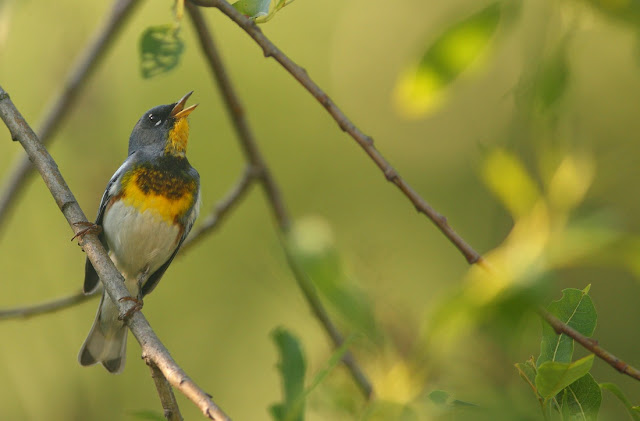Warblers of the Flambeau 18 June 2012
I don’t know who coined the term “Birds of Two Worlds”, but it has been an important rally cry in international conservation since the early 1990s, as I recall. Wood Warblers and other “Neotrops”, long distance migrants moving between the North American continent and the tropical Americas, cross numerous political borders in completing their life cycles. Many of these birds hatch from the egg in Canada and overwinter in northern South America, even within the Amazon basin. They are truly tropical wonders, romantic and poetic travelers, miniature, charismatic, colorful and determined. At less than five inches long, they risk it all every year to accomplish through muscle and verve what humans would, at the very least, find impossibly frightening.
Blackburnian Warbler
Northern Parula
It is June. Wood Warblers of many species have reached the vast and wild lands of the Flambeau River in Northern Wisconsin. They sing to proclaim territories, and they eagerly seek out habitats that provide food for nestlings and the right blend of structure for nesting. Each habitat has its own spectacular assemblage of bird species, and each habitat must remain, here and there, for these assemblages to continue into the future. Today, I spent the afternoon afield in search of images that would paint a picture of boreal beauty. I found Northern Parula and Blackburnian Warblers, eagerly defending territories.
The Northern Parula and the Blackburnian Warbler are two species that, in their color, song, and habitat choice, beckon me to the great North woods. In their colors and songs, they have etched into my mind a stoic image of balsam fir, spruce, hemlock and northern lakes. I see old, bare branches of some swamp-killed conifer, and I see long, old-man’s beard lichen hanging from black spruce boughs. Gray lichen encrusts the low branches of a balsam fir. The crowns of spruce and balsam fir are perfect points, dark, and strongly contrasting with the baby greens of sugar maple, aspen, and paper birch. This is the land of black bears and wolves, a cool chill to the morning air, and cobalt blue June skies that promise strawberry snacks and northern pike fighting on the end of a fishing line.
But most months of the year, my favorite embassadors of the North woods are truly tropical birds. They need our vacationlands to do their most important life’s work, reproducing the next generation, but they spend most of their lives foraging and even declaring foraging territories in the varied habitats of Belize, Guatemala, Costa Rica, Venezuela, Jamaica, Puerto Rico… They are birds that see coffee, Brahma bulls, primary cloud forest, cohune palms, and mangrove swamps. The colors in their feathers are the very molecules sequestered through diets of tropical foods. My boreal gems are tropical. They bring the rainforest home to Wisconsin. The chilly boreal forest would be so much less without the abundant tropical life high in the canopy.
All images were taken with a Canon 40D and 300mm f4 IS Canon lens. All wonderful moments afield today were shared with someone with a special appreciation for the birds...My Mom! Thanks Mom!










